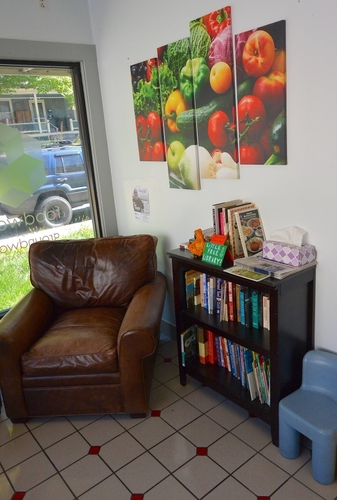BRATTLEBORO — Foodworks, the new food shelf on 141 Canal St., looks just like a neighborhood market.
And that's by design, said Christine Colascione.
Colascione is the coordinator of Groundworks Collaborative's food shelf program, which made the move last month from the cramped quarters of the Drop-In Center on 60 South Main St. to the former site of Domino's Pizza.
“We wanted people to come inside and feel comfortable,” she said.
That was a hard thing to do at the Drop-In Center, which started its food pantry in the 1980s.
Groundworks Development Director Libby Bennett said that even after the facility expanded into a two-bay garage at the back of the property in 2015, there wasn't enough room for people to navigate the space and pick up the food they needed.
Given it is the region's most heavily used food shelf, with about 1,400 households - more than 3,700 people - served in 2018, space and accessibility were issues on South Main Street.
By signing a lease on the Domino's building, Groundworks now has an accessible, free-standing food shelf with wider aisles and more space.
“The plan was to decouple the food shelf from the Drop-In Center,” Bennett said. “Now, both places have more room and are more welcoming.”
New name
The food shelf was renamed Foodworks, a moniker that was chosen after polling staff and clients, Bennett said.
It opened on Aug. 12, but Groundworks held an open house on Sept. 19 for local social-service providers and other community members to get a good look at the changes.
The first thing visitors will notice is the comfortable waiting area inside by the front door, with chairs and a “little library” where visitors can take or leave books.
There also are now hand baskets and small grocery carts that people can use for shopping.
“It's better than lugging a banana box around,” Colascione said.
Blue plastic bins tilted forward on metal shelving are filled with fresh fruits and vegetables - the first food people see when they enter the food shelf.
Refrigerated cases hold perishables, and chest freezers, a holdover from South Main Street, hold frozen foods.
“This building was empty when we got it,” Bennett said. “We had to put everything together from scratch.”
A large walk-in refrigerator helps Foodworks store the large amounts of fruits and vegetables it gets from the Vermont Foodbank, the supplier of much of the food shelf's inventory. That, and a new walk-in freezer, accounted for much of the $15,000 cost of the move, Bennett said.
Food triage
In addition to having a brighter and more spacious food shelf for its clients, the space is now open for additional hours.
The new hours for Foodworks are: Mondays, 11 a.m. to 4 p.m.; Tuesdays, noon to 2 p.m. (for seniors only) and 2 to 4 p.m. (open to all); Wednesdays, 1 to 6 p.m.; Fridays, noon to 4 p.m.; and the last Saturday of the month, 9 a.m. to noon. Foodworks is closed on Thursdays and Sundays.
Foodworks is intended to be a supplement for those who receive food aid from 3SquaresVT (formerly known as food stamps). Colascione said the food shelf usually sees more activity at the end of each month, when many people run out of 3Squares benefits.
Staying open later in the day, she said, will give staff and volunteers more time to go to the Foodbank's distribution depot on Putney Road, as well as to local markets and convenience stores, to pick up surplus food.
Getting food out to those who need it is the primary goal of Foodworks. Even though the Drop-In Center and food shelf are no longer under the same roof, Foodworks will continue to prove food for the day shelter at the Drop-In Center.
Bennett said Foodworks interviews each of its patrons to determine what plan is needed. It factors in each person's current situation, such as being without housing, a place to store food, or a means of cooking it - or whether a person has lost their job, or is relying on Social Security to get by.
Food distribution guidelines are based on the price and quantity of each item, and range from “take one per household” to “take as much as you need.” The fruits and vegetables usually fall into the latter category. And no one is turned away if it is an emergency.
“We have some clients who come here just for the produce, because they are so expensive in the grocery store,” Colascione said.
